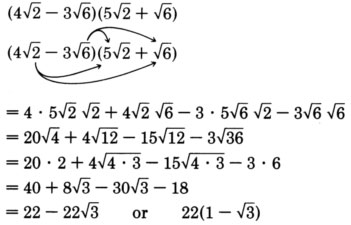This module is from Elementary Algebra by Denny Burzynski and Wade Ellis, Jr.
The distinction between the principal square root of the number x and the secondary square root of the number x is made by explanation and by example. The simplification of the radical expressions that both involve and do not involve fractions is shown in many detailed examples; this is followed by an explanation of how and why radicals are eliminated from the denominator of a radical expression. Real-life applications of radical equations have been included, such as problems involving daily output, daily sales, electronic resonance frequency, and kinetic energy.Objectives of this module: understand the process used in adding and subtracting square roots, be able to add and subtract square roots.
Overview
- The Logic Behind The Process
- The Process
The logic behind the process
Now we will study methods of simplifying radical expressions such as
The procedure for adding and subtracting square root expressions will become apparent if we think back to the procedure we used for simplifying polynomial expressions such as
The variables
and
are letters representing some unknown quantities (perhaps
represents
and
represents
). Combining like terms gives us
The process
Let’s consider the expression
There are two ways to look at the simplification process:
- We are asking, “How many square roots of 3 do we have?”
means we have 4 “square roots of 3”
means we have 8 “square roots of 3”
Thus, altogether we have 12 “square roots of 3.”
- We can also use the idea of combining like terms. If we recall, the process of combining like terms is based on the distributive property
We could simplify
using the distributive property.
Both methods will give us the same result. The first method is probably a bit quicker, but keep in mind, however, that the process works because it is based on one of the basic rules of algebra, the distributive property of real numbers.
Sample set a
Simplify the following radical expressions.
Practice set a
Find each sum or difference.
Sample set b
Practice set b
Simplify each by performing the indicated operation.
Exercises
For the following problems, simplify each expression by performing the indicated operation.
Exercises for review
(
[link] ) Simplify
(
[link] ) Simplify
(
[link] ) Write
so that only positive exponents appear.
(
[link] ) Simplify
(
[link] ) Simplify
by rationalizing the denominator.



